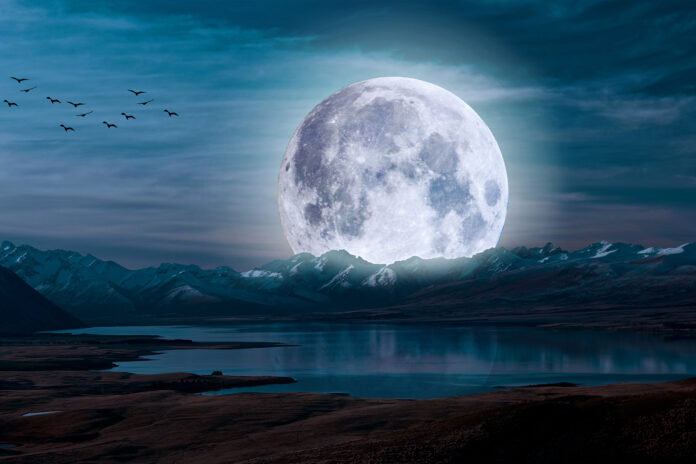In the vast expanse of the night sky, the Moon emerges as a mesmerizing celestial companion, casting its silvery glow and captivating the imaginations of poets, scientists, and dreamers throughout the ages. Beyond its ethereal beauty, the Moon plays a pivotal role in Earth’s cosmic dance, influencing tides, inspiring folklore, and serving as a celestial laboratory for scientific exploration. Let’s embark on a journey to unravel the fascinating facts that make the Moon an object of wonder and curiosity.
Earth’s Natural Satellite
The Moon is Earth’s only natural satellite, orbiting our planet at an average distance of about 238,855 miles (384,400 kilometers). It is comparatively small, with a diameter of approximately 2,159 miles (3,474 kilometers), making it about 1/6th the size of Earth.
Lunar Phases
The Moon goes through a cycle of phases as it orbits Earth. From the waxing crescent to the full moon and then to the waning crescent, these phases result from the varying positions of the Moon, Earth, and the Sun. The cycle repeats approximately every 29.5 days, a period known as a synodic month.
Tidal Forces
One of the Moon’s most profound influences on Earth is its gravitational pull, which causes tides in the planet’s oceans. The gravitational interaction between the Moon and Earth results in two high tides and two low tides each day. This tidal force also slightly elongates the Earth along the line connecting the centers of the two celestial bodies.
Dark and Light Regions
The Moon’s surface is divided into dark, flat plains known as maria (Latin for seas) and brighter, rugged highlands. The maria, formed by ancient volcanic activity, give the Moon its distinctive “man in the moon” appearance when viewed from Earth.
Lunar Maria Origins
The lunar maria were created billions of years ago when molten rock welled up from the Moon’s interior and flooded large basins created by ancient asteroid impacts. These vast plains, visible with the naked eye, cover about 16% of the Moon’s surface.
Moonquakes
While Earth experiences earthquakes, the Moon has its own seismic activity known as moonquakes. These quakes are less frequent and intense than their Earthly counterparts but can last longer. They are believed to be caused by the gravitational interactions between the Earth and the Moon.
Craters and Impact History
The Moon’s surface is adorned with countless craters, the scars of ancient asteroid and meteoroid impacts. The most well-known is the giant crater Tycho, visible from Earth with the naked eye. These impact sites provide a valuable record of the Moon’s history and the frequency of collisions in our solar system.
Lack of Atmosphere
Unlike Earth, the Moon lacks a significant atmosphere. This absence means that the Moon has no weather, no wind, and no protection from the harshness of space. Without an atmosphere to scatter sunlight, the sky on the Moon is pitch black, even during the day.
Extreme Temperatures
The Moon experiences extreme temperature variations due to its lack of atmosphere. Daytime temperatures can soar to over 200 degrees Fahrenheit (93 degrees Celsius), while nighttime temperatures can plummet to around -243 degrees Fahrenheit (-153 degrees Celsius).
Moon’s Synchronous Rotation
The Moon is tidally locked to Earth, meaning it rotates on its axis in the same amount of time it takes to complete one orbit around our planet. As a result, the same side of the Moon always faces Earth. The side we see from Earth is known as the near side, while the hidden side is the far side.
Apollo Missions
The Apollo program, initiated by NASA in the 1960s and 1970s, successfully landed humans on the Moon. The first manned mission, Apollo 11, saw astronauts Neil Armstrong and Buzz Aldrin take the historic steps on the lunar surface on July 20, 1969. A total of six Apollo missions brought twelve astronauts to the Moon, leaving an indelible mark on human exploration.
Moon’s Origin
The prevailing scientific theory regarding the Moon’s origin is the giant impact hypothesis. According to this theory, a Mars-sized object collided with the early Earth, and the debris from this impact eventually coalesced to form the Moon.
Earthshine
Earthshine is the phenomenon where sunlight reflects off the Earth’s surface and illuminates the dark portion of the Moon. This soft glow, visible during the waxing and waning crescent phases, offers a poetic interplay of light between our celestial neighbors.
Lunar Regolith
The Moon’s surface is covered with a layer of fine, powdery soil-like material called regolith. This layer is the result of countless meteoroid impacts over millions of years. The regolith is several meters deep in some places and poses challenges for lunar exploration.
Future Lunar Exploration
The Moon remains a focal point for future space exploration. Various space agencies, including NASA, ESA, and others, have plans for lunar missions, with ambitions ranging from establishing a lunar gateway for further space exploration to setting up a sustainable human presence on the Moon.
Conclusion
In conclusion, the Moon, with its timeless beauty and enigmatic characteristics, continues to be a celestial muse for scientists, astronomers, and sky gazers alike. As humanity looks towards the cosmos, the Moon stands as a testament to the wonders of our solar system and the boundless possibilities that lie beyond our earthly abode. Its silvery glow continues to inspire, inviting us to dream, explore, and reach for the stars.

